Leiomyosarcoma of the Larynx - Diagnosis and Treatment Protocol A Case Report and Review of the Literature
Authors:
J. Astl 1,2; B. Synková 1; D. Kovář 1; J. Rotnágl 1; I. Tučková 3; T. Belšan 4; P. Georgiev 5
Authors‘ workplace:
Institute for Postgraduate Medical Education Prague
2; Department of Pathology, Military Faculty Hospital in Prague
3; Department of Otorhinolaryngology and Maxilofacial Surgery, the rd Faculty of Medicine of the Charles University and Military Faculty Hospital in Prague
3; Department of Radiology, Military Faculty Hospital in Prague
4; Department of Oncology 1st Faculty of Medicine of Charles University, Military Faculty Hospital in Prague
5
Published in:
Otorinolaryngol Foniatr, 68, 2019, No. 2, pp. 109-113.
Category:
Case Reports
Overview
Leiomyosarcoma of the larynx is known as a very rare malignancy. Soft tissue sarcomas of the head and neck region account for 4–15% of all the soft tissue sarcomas and less than 1% of all the neoplasms in this region. The leiomyosarcomas in this area originate from blood vessels or smooth muscles. Some authors described the development of a leiomyosarcoma from the heterotopic mesenchymal tissue in the larynx. The histological diagnosis of the leiomyosarcoma depends on the histology and the immunohistochemical investigation. The case presented here is of a 35-year-old man suffering of shortness of breath and hoarseness. Indirect laryngoscopy showed a pedunculated tumor on the right vocal cord and petiolus epiglotis lesion causing no airway obstruction in the first time with rapid growing of them in the short time during the initial chemotherapy caused the suffocation . The case presented is one of a laryngeal leiomysoarcoma with the clinical, radiological and histological findings and therapy results. We are presenting a new case of primary leiomyosarcoma of the larynx.
Keywords:
Larynx – Leiomyosarcoma
INTRODUCE
Laryngeal carcinoma accounts for 95–98% of laryngeal malignancies (11). Less than 1% of laryngeal malignant tumors are sarcomas (5, 8, 14). Primary laryngeal sarcomas are rare (less than 1% of all malignant tumors). More than 50% of laryngeal sarcomas are fibrosarcomas. The chondrosarcomas, osteosarcomas are the next frequent sarcomas in the larynx and leiomyosarcomas, liposarcomas and rhabdomyosarcomas are rare. Leiomyosarcomas originate from smooth muscles and represent 5–6% of all soft-tissue sarcomas (11). The chondrosarcomas of the larynx was described mostly in the literature (6).
Laryngeal leiomyosarcoma is extremely rare (5, 10). The challenging histological diagnosis of leiomyosarcoma depends on the immunohistochemical investigation. The literature did not present the recommended therapy protocol for laryngeal leiomyosarcoma.
CASE REPORT
A 35-year-old man was referred to the otorhinolaryngology outpatient clinic with a 5-month history of hoarseness. He had not been smoking. He denied any alcohol consumption.
A laryngeal examination revealed a pedunculated mass in the petiolus epiglotis and the right vocal cord. There was a partial fixation of the right vocal cord and an approximately 10x8x12 mm tumor arising from the petiolus and right vocal cord (Fig. 1).
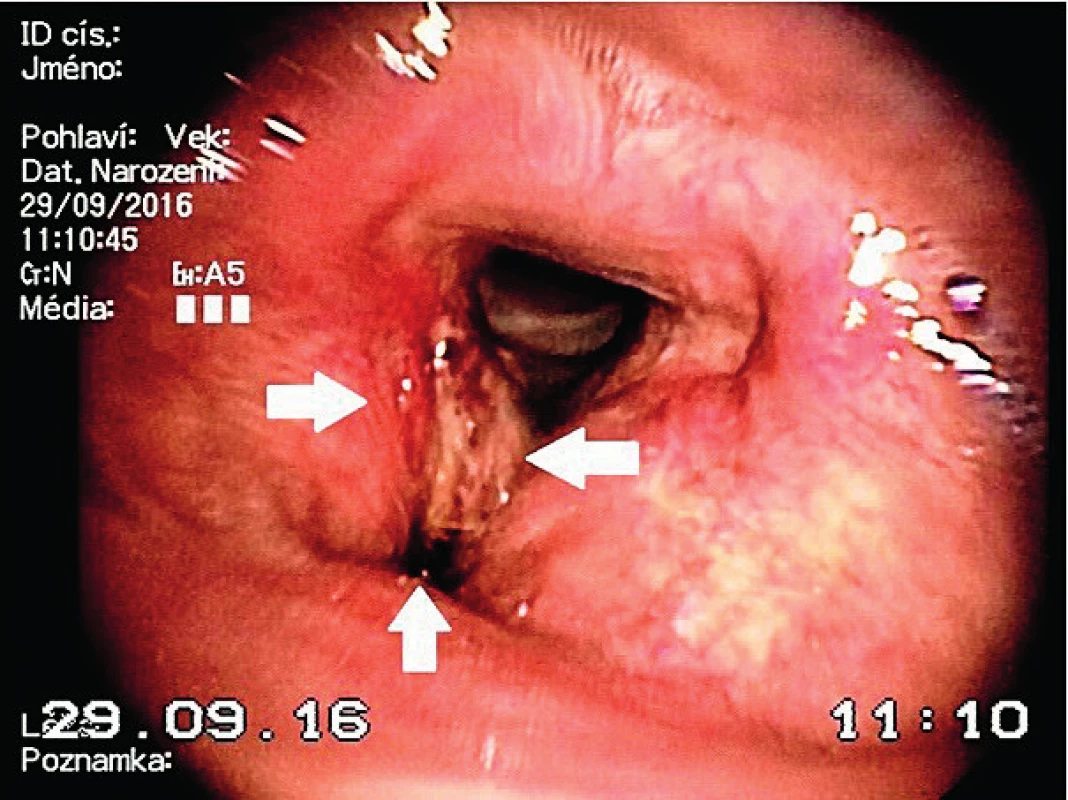
A biopsy was taken from the lesion with suspension microlaryngoscopy under general anesthesia (direct laryngoskopy Kleinsasser procedure). A histopathological diagnosis (immunohistopathology including) of rhadbomyosarcoma was made based on the sample.
The MRI scan of the neck was done. The MRI showed the tumor in the larynx (no invasion to the thyroid cartilage) and no presence of enlarged lymph nodes (see. Fig. 2a and 2b).
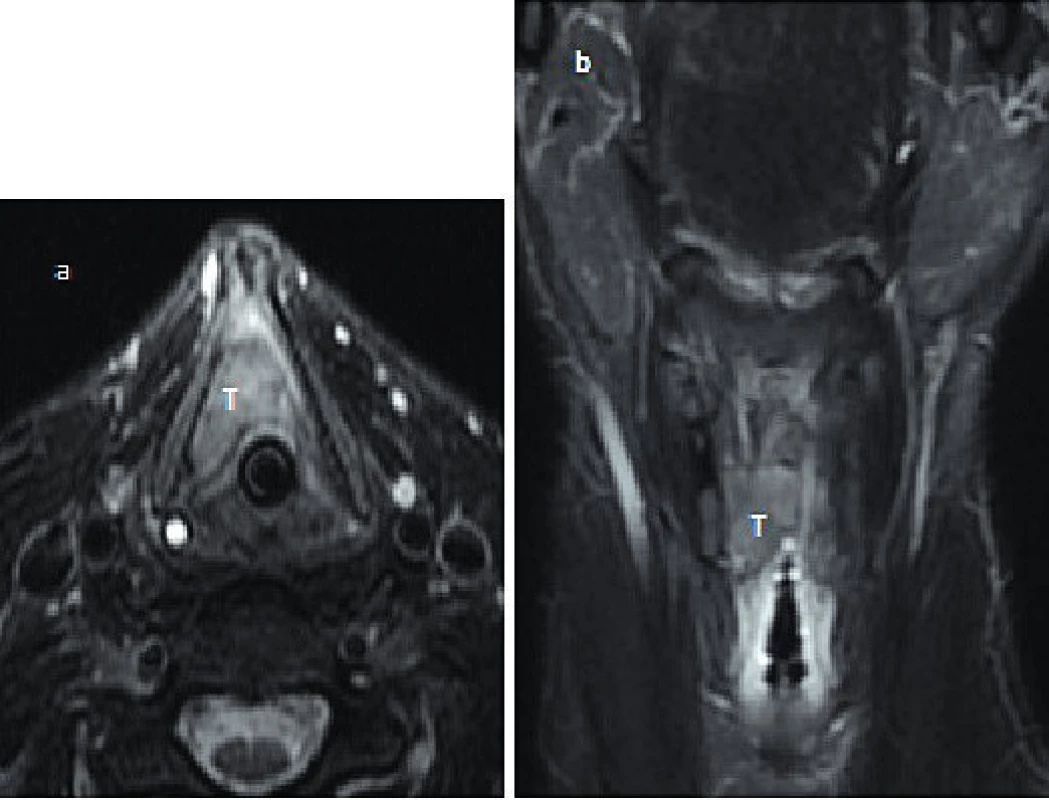
The chemotherapy by doxorubicin 130 mg of two series was the first modality used in treatment protocol. The intravenous application of doxorubicin followed the therapy by dexamethasone 12 mg intravenously and palonosteron hydrochloride 20 μg/kg as an antiemetic and antinauseant agents. The next application of dexamethasone followed the doxorubicine therapy (doses 12mg intravenously) in 48 hours.
After the two series of chemotherapy the tumor had enlarged. The suffocation indicated an emergency tracheostomy. The tumor grew and obstructed the larynx completely (Fig. 3).
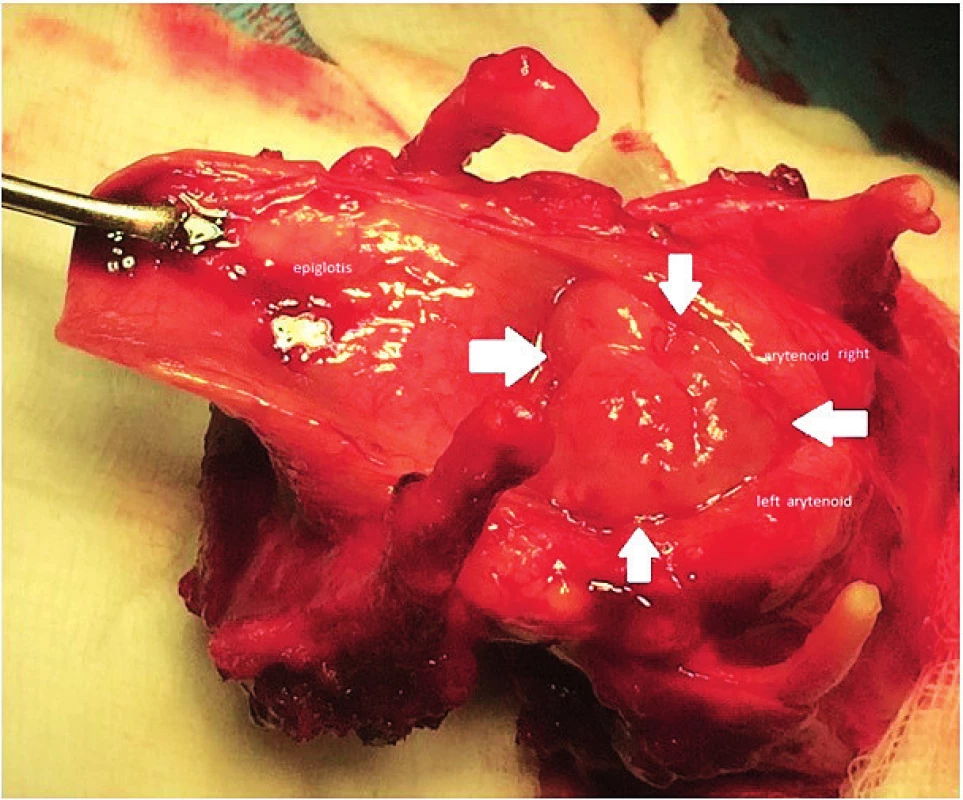
Next step was to do a total laryngectomy. Because the lymph node status was N0 and chemotherapy was used previously, we did not perform an elective neck dissection.
The histological analysis showed a sarcoma with detection of fused cells of variable dimensions. The cells were focal irregular and hyperchromic (Fig. 4). They also ranged from a large atypical form to a monstrous cell form associated with high mitotic activity.
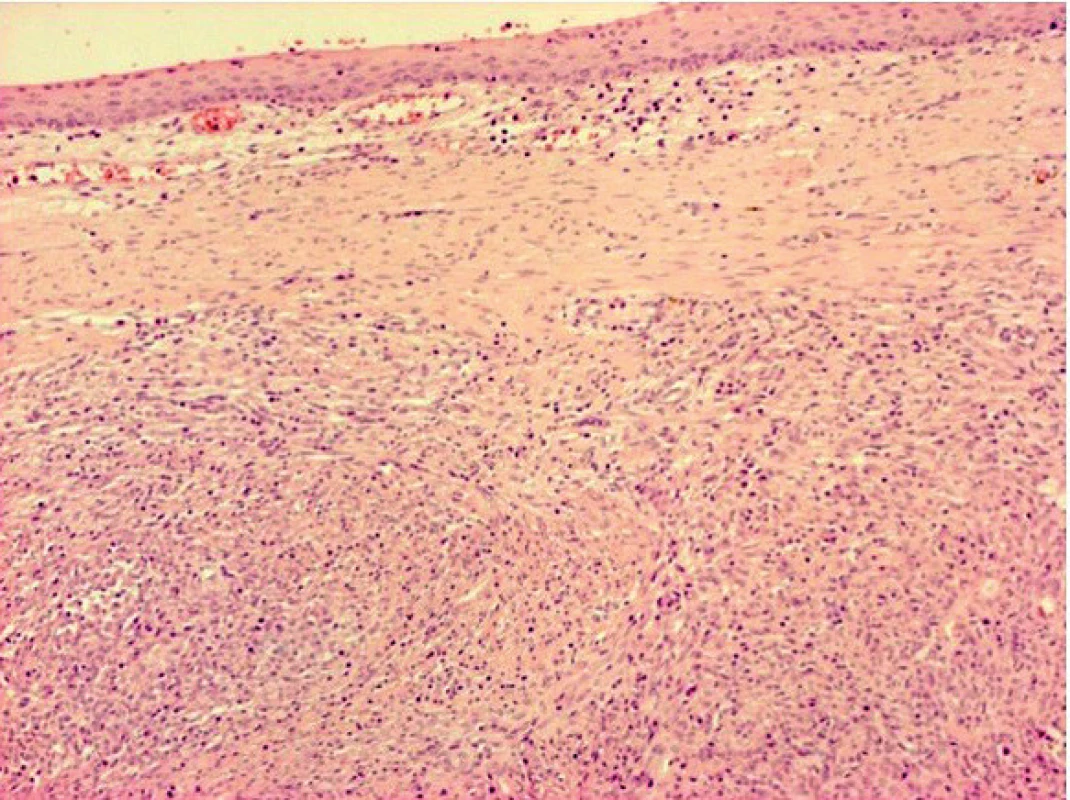
The neoplastic cells strongly expressed desmin, sarcomeric actin was positive 2+ - 3+, and myogenin 3+ was positive (see Fig. 4) in immunohistochemical testing, confirming the diagnosis of leiomyosarcoma. The immunostainings with myoD1 nuclear negative, Ki67 5-10% positive, p63 in tumor negative, myoepielial and squamous cell positive 3+, H kaldesmon negative in tumor and positive 3+ in in vesseles muscular tissue, ALK negativeSMA focal positive, CK was negative. The diagnosis was a leiomyosarcoma. The morphology and immunofenotype with signs of dedifferentiation put it in a Grade 2 or low board 3+ (for low Ki-67).
The TNM classification was T2N0M0 and stadium II (no signs of the growing of the tumor in the thyroid cartilage, no invasion over the larynx to the subglotic space and/or preepiglotic and/or postcricoid area). The next step of the treatment was irradiation. The photon therapy used doses of 66,7 Gray to the neck region (the 55 Grays to lymph nodes on the neck area).
Informed consent was obtained from the patient for this case presentation. The patient has been in a disease free interval for 12 months now. He feels good and has begun voice rehabilitation (oesophageal voice).
Aim of paper: we would like added a new case of leiomysarcoma of the larynx and present the individual treatment protocol.
DISCUSSION
Leiomyosarcoma is usually found in the female genital tract, retroperitoneum, the wall of the gastrointestinal tract and subcutaneous tissues. An appearance of this malignant tumor in the larynx is extremely rare and may be difficult to diagnose. Because of its rarity, little information exists on its management and prognosis. Jackson et al. in 1939 (8) were the first to report such a case. The reviewed patients survive 12 months free of disease after start of therapy (chemotherapy, surgery and irradiation).
Out of total 42 cases reported, 29 patients were males and 13 were females. The average age was 45 years. Higher incidence is supposed to occur among the middle-aged or elderly (3). A bimodal tendency exists within 40% of cases recorded in patients 1–29 years old and 40% occurring in patients 51–67 years of age. Six cases occurred in children (3, 10, 11, 14). Our patient can be associated with the first patient group of 1-29 year old. Out of 43 patients (we have added one case to the literature) the leiomyosarcoma in the head and neck region occurs in 70% of the male patients and 30% of the female patients.
In the literature some risk factors are described for the presence of sarcomas such as radiation exposure, surgery, tuberous sclerosis, neurofibromatosis, Werner syndrome, Gardner syndrome, retinoblastoma, multiple basal cell carcinoma syndrome, Turcot syndrome, and Epstein–Barr virus infection in immunosuppressed patients (5, 7, 13). The current patient did not have any of the described factors for the development of leiomyosarcoma.
Leiomyosarcoma was reported as glottis (48%), supraglottis (32%), and supraglottis-glottis (6.5%) (9). Similarly, the current case had a pedunculated supraglotic and glotic tumor mass on the right side.
The clinical presentation of leiomyosarcoma is like other laryngeal tumors with progressive hoarseness, dyspnoea, and dysphagia (11). The reported duration of the symptoms may vary from weeks to years (1). In the current case, the symptoms of shortness of breath and hoarseness had been present for 5 months before the initial biopsy. The growth of the tumor was faster than in the last 4 weeks the tumor obstructed the laryngeal and tracheal lumen completely.
Leiomyosarcoma associated with obstructive features that may require an emergency laryngectomy or emergency tracheostomy (12). The patient presented the suffocation after the initial two series of chemotherapy. First-line treatment options include gemcitabine-docetaxel or doxorubicin with or without ifosfamide. Novel targeted therapies are under investigation in an attempt to devise more effective treatment strategies (4, 9, 14). We used the doxorubicin with anticomiting therapy two times as a neoadjuvanet chemotherapy. The answer to the therapy was unsufficient and the tumor progress and suffocation later. For the suffocation the urgent trachestomy was done in this case.
We used the neoadjuvant treatment in this case with the primary diagnosis of rhadbomysarcoma from biopsy by direct laryngoscopy (the diagnosis of leiomysoracoma was done later after laryngectomy). Primary chemotherapy has been used in a small number of uterine cases, with 20–50% response and less than 1 year survival. No significant response has been seen with isolated radiation therapy on its own, whether for the primary tumour or for metastases. In this case we have a diagnosis of rhadbomyosarcoma in the initial therapy time. This was the reason why we used the neoadjuvant chemotherapy before surgery (1, 2, 9, 12, 16).
CT and magnetic resonance imaging, provide adjunctive information as they show the local extent and the size of the tumor as well as giving information regarding the lymph node status and the vascular component of the lesion (8, 14). In this case, CT was used for the initial evaluation. No lymph node metasis and spread of the tumor through the laryngeal cartilages was presented.
The treatment modality of choice for leiomyosarcoma is surgery (2, 4, 16). Surgical modalities vary considerably according to site and extent of lesion. We used the laryngectomy for the growing tumor with the full obstruction of the lumen of air way. The literature discribed the surgery from conservative procedures, like microlaryngeal surgery, laser debulking, vertical partial laryngectomy and simple partial laryngectomy, to more aggressive procedures, such as total laryngectomy. However, conservative surgeries have high recurrence rates and thus are generally not recommended. This data was the reason for the indication of total laryngectomy in the presented case.
The literature presented that head and neck leiomyosarcomas rarely metastasize to the lymph nodes (11). The current patient did not have metastasis to the lymph nodes.For this fact we have done the laryngectomy only. The patient have not presentation of metastates in lung, liver, bone, brain, and skin (10, 14). Noting the fact that the tumour has haematogenous dissemination, less than 10–15% of patients may have cervical lymph node involvement, thus limiting the role of elective cervical dissection. Because the CT scan did not showed any metastases we did not done the neck dissection and/or lymph node resection.
Histologically, leiomyosarcoma is characterized by prominent interlacing bundles and fasicles of elongated spindle cells with elongated ‘cigar-shaped’ blunt-ended nuclei, prominent nucleoli and abundant eosinophilic cytoplasm (15). The mitotic rate is usually increased and atypical mitotic fi gures are present. On Immunostaining the leiomyosarcoma is positive for muscle - specific actin and negative for S-100 protein (11). The presented case has spidle cell a spheric cells sarcoma with focal atypic cells (monstra cell architectonic). The mitotic activity was high with a frequent atypic mitoses.
In presented case the analyse was done where sarcomeric actin was positive 3+ in tumor mass, outside was negative, the myofibroblast of granular tissue 3+. Desmin 3+ in hole sample, muscle cells 3+ and nuclei myogenin was negative in tumor cells too.The immunostainings with myoD1 nuclear marker was negative. On the second hand Ki67 was positive in 5-10% cells in pleomorfic areas, outside less 5%, cytokeratine marker p63 was in tumor negative, myoepielial and squamous cell positive 3+. The analyse showed H kaldesmon negative in tumor and positive 3+ in vesseles. ALK negative, SMA focal positive, CK was negative. The morphology and immunophenotype/genotype (L45/17) the histology is leiomyocelular sarcoma with dediferentiation. Grade II-III (for low Ki-67).
Radiotherapy is described an adjuvant therapeutic modality that may have a role in recurrence or in residual disease but is less effective as a primary treatment modality and chemotherapy also has a limited role (11). The data did not showed effect improvment or disease-free survival with adjuvant radiotherapy, compared with observation only. On the second hand adjuvant chemotherapy following complete surgical resection leiomysarcoma reported promising results (2, 4). After neoadjuvant chemoterapy and the total laryngectomy we advocate for radiotherapy. No one study showed the effect of the protocol of neoadjuvant chemoterapy, surgery and adjuvant radiotherapy for leiomysarcoma generally. This was the reason of indication of this protocol in this case too.
Eeles et al. (5) studied 103 cases of head and neck sarcomas, in which they found a 5-year survival rate, 5-year local recurrence free survival and 5-year metastasis free survival of 45%, 39% and 60%, respectively. Owing to rarity of leiomyosarcoma a specific mention of its recurrence and metastasis is not available in present literature yet. Our patient is without the disease now (no evidence of disease yet). But the interval after the inicial treatment is very short. The prognosis of the leiomysarcoma is moderate (5-year survival interval about 50%). In presented case we can not consider the prognosis yet. No one paper published the relevant survival data for leiomysarcoma of the larynx. The survival rate, local recurrence free interval and metastasis free inetrval for leiomysarcoma is unknown generally.
CONCLUSION
Leiomyosarcoma is a very rare malignancy. Laryngeal leiomyosarcomas are less aggressive than rhadbomyosarcomas and surgery treatment is an effective treatment modality. Other treatment options, such as chemotherapy, are available. We recommend it for the experience from other location (uterine) in neoadjuvant protocol (Fig. 5). As the number of reported laryngeal leiomyosarcoma cases is limited (less 60 cases in literature). The tumor’s prognosis and clinical behavior has not yet been fully elucidated. Due to the risk of recurrence, a long period of follow-up is mandatory after treatment.
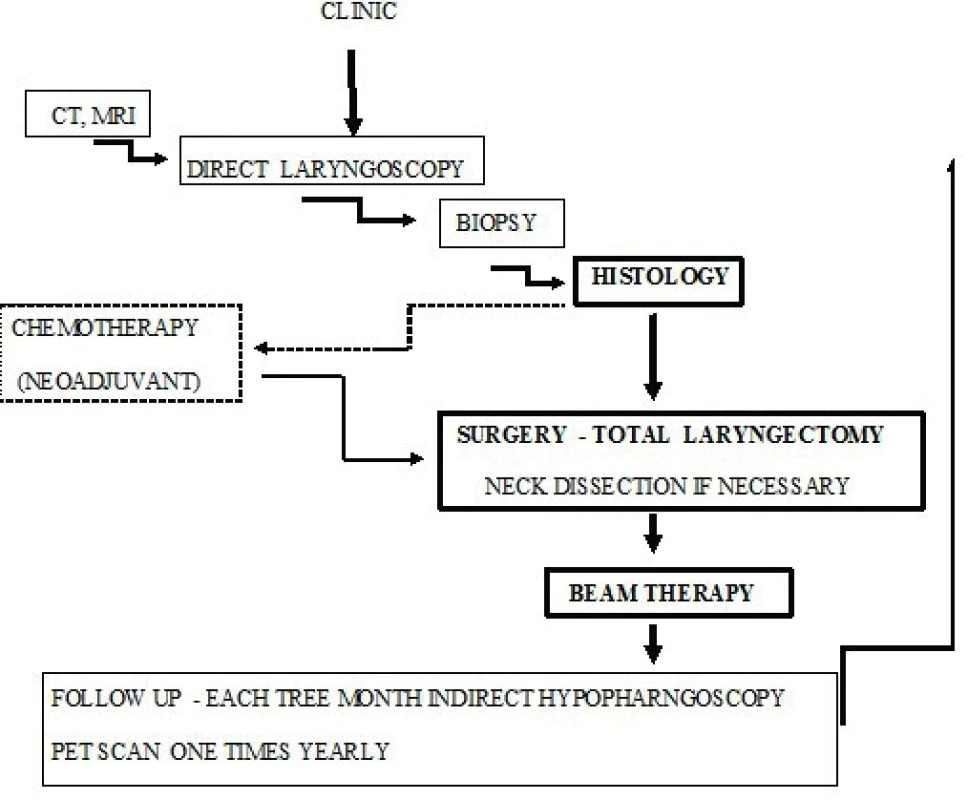
Financial support and sponsorship
This work was supported by Project of Czech Ministry of Defense MO 1012.
Conflicts of interest
There are no conflicts of interest.
Adresa ke korespondenci:
Prof. MUDr. Jaromír Astl, CSc.
Department of Otorhinolaryngology and Maxilofacial Surgery, the 3rd Faculty of Medicine of the Charles University and Military Faculty Hospital in Prague:
Prague 6Institute for Postgraduate Medical Education Prague
U Vojenské nemocnice 1200
169 02 Praha 6
e-mail: jaromir.astl@uvn.cz
Sources
1. Abbas, A., Ikram, M., Yaqoob, N.: Leiomyosarcoma of the larynx: A case report. Ear Nose Throat J, 84, 2005, 7, s. 435-436, 440.
2. Chen, J. M., Novick, W. H., Logan, C. A.: Leiomyosarcoma of the larynx. J Otolaryngol, 20, 1991, 5, s. 345-348.
3. Chizh, G. I., Ogorodnikova, L. S., Birina, L. M. et al.: Leiomyosarcoma of the larynx in an 8-year-old girl. Vestn Otorinolaringol, 1976, 5, s. 106-107.
4. Darouassi, Y., Bouaity, B., Zalagh, M. et al.: Laryngeal leiomyosarcoma. B-ent, 1, 2005, 3, s. 145-149.
5. Eeles, R. A., Fisher, C., A‘Hern, R. P. et al.: Head and neck sarcomas: prognostic factors and implications for treatment. Br J Cancer, 68, 1993, 1, s. 201-207.
6. Formánek, M., Zeleník, K., Dvořáčková, J. et al.: Chondrosarkom prstencové chrupavky. Otorinolaryng a Foniat /Prague/, 62, 2013, 3, s. 136-139.
7. Helmberger, R. C., Croker, B. P., Mancuso, A. A.: Leiomyosarcoma of the larynx presenting as a laryngopyocele. AJNR Am J Neuroradiol, 17, 1996, 6, s. 1112-1114.
8. Jackson, C., Jackson, C. L.: Sarcoma of the larynx. In: Jackson C., editor, Cancer of the larynx. Philadelphia: W.B. Saunders, 1939, s. 167-168.
9. Marioni, G., Bertino, G., Mariuzzi, L. et al.: Laryngeal leiomyosarcoma. J Laryngol Otol, 114, 2000, 5, s. 398-401.
10. Morera Serna, E., Perez Fernandez, C. A., de la Fuente Jambrina, C. et al.: Laryngeal leiomyosarcoma. Acta Otorrinolaringol Esp, 58, 2007, 9, s. 445-448.
11. Skoulakis, C. E., Stavroulaki, P., Moschotzopoulos, P. et al.: Laryngeal leiomyosarcoma: a case report and review of the literature. Eur Arch Otorhinolaryngol, 263, 2006, 10, s. 929-934.
12. Tewary, A. K., Pahor, A. L.: Leiomyosarcoma of the larynx: emergency laryngectomy. J Laryngol Otol, 105, 1991, 2, s. 134-136.
13. Timmons, C. F., Dawson, D. B., Richards, C. S. et al.: Epstein-Barr virus-associated leiomyosarcomas in liver transplantation recipients. Origin from either donor or recipient tissue. Cancer, 76, 1995, 8, s. 1481-1489.
14. Tran, L. M., Mark, R., Meier, R. et al.: Sarcomas of the head and neck. Prognostic factors and treatment strategies. Cancer, 70, 1992, 1, s. 169-177.
15. Wadhwa, A. K., Gallivan, H., O‘Hara, B. J. et al.: Leiomyosarcoma of the larynx: diagnosis aided by advances in immunohistochemical staining. Ear Nose Throat J, 79, 2000, 1, s. 42-46.
16. Yoshizaki, T., Horikawa, T., Nonomura, A. et al.: Leiomyosarcoma of the larynx. J Laryngol Otol, 113, 1999, 2, s. 167-169.
Labels
Audiology Paediatric ENT ENT (Otorhinolaryngology)Article was published in
Otorhinolaryngology and Phoniatrics
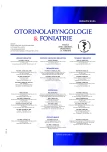
2019 Issue 2
Most read in this issue
- ideo Head Impulse Test – a Novel Method for Examination of Vestibular Apparatus
- The Effect of Voice Training Using Humming Resonance Exercises at Students – Preliminary Study
- Inverted Sinonasal Papilloma: Possibility of Prediction of the Tumor Insertion
- Solitary Fibrous Tumour of the Parotid Gland. Case Report and Review of the Literature
